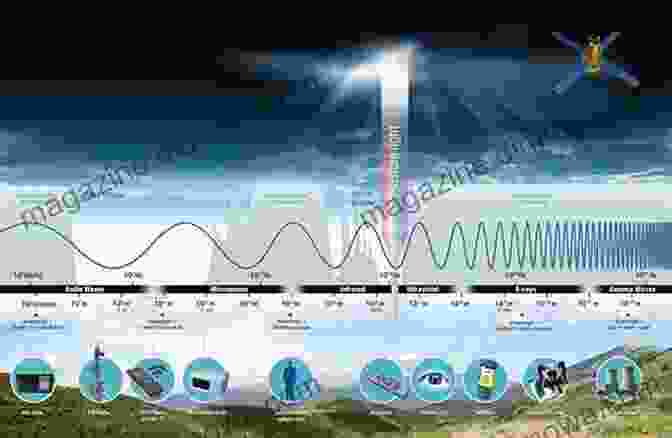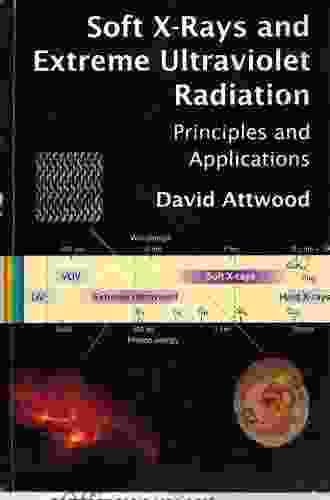Soft Rays And Extreme Ultraviolet Radiation: Unveiling the Electromagnetic Spectrum

The electromagnetic spectrum is a vast and complex continuum of energy that permeates the universe. It encompasses a wide range of wavelengths, from the longest radio waves to the shortest gamma rays. Each wavelength corresponds to a specific type of radiation, which can be characterized by its frequency, energy, and properties.
In this article, we will explore two fascinating regions of the electromagnetic spectrum: soft rays and extreme ultraviolet radiation. We will delve into their unique characteristics, scientific applications, and the groundbreaking discoveries they have enabled in astronomy and astrophysics.
4.5 out of 5
| Language | : | English |
| File size | : | 45025 KB |
| Text-to-Speech | : | Enabled |
| Screen Reader | : | Supported |
| Enhanced typesetting | : | Enabled |
| Print length | : | 486 pages |
Soft Rays: Penetrating the Cosmic Veil
Soft rays, also known as soft X-rays, occupy a narrow band of the electromagnetic spectrum between extreme ultraviolet radiation and hard X-rays. They are characterized by their relatively low energy and long wavelengths.

Soft rays have a unique ability to penetrate cosmic clouds and dust, which makes them invaluable for studying obscured celestial objects. They can reveal hidden structures within galaxies, such as star-forming regions, supernova remnants, and black holes.
One of the most exciting applications of soft ray astronomy is the study of active galactic nuclei (AGN). These powerful engines of energy are found at the centers of galaxies and emit copious amounts of soft rays. By analyzing the soft ray emission from AGN, astronomers can gain insights into the accretion processes, black hole masses, and the growth of supermassive black holes.
Extreme Ultraviolet Radiation: Unlocking the Secrets of the Solar System
Extreme ultraviolet (EUV) radiation lies at the higher energy end of the electromagnetic spectrum, just beyond the range of soft rays. It has wavelengths that are shorter than soft rays and longer than X-rays.

EUV radiation is particularly important for studying the Sun and the outer atmospheres of planets. The Sun's corona, the outermost layer of its atmosphere, emits copious amounts of EUV radiation. By analyzing the EUV emission from the corona, scientists can study its temperature, density, and dynamic processes, such as solar flares and coronal mass ejections.
EUV radiation also plays a crucial role in shaping the atmospheres of planets. It can ionize atoms and molecules in planetary atmospheres, creating charged particles that can interact with the magnetic field and influence the planet's climate and habitability.
Scientific Instruments: Unveiling the Hidden
The scientific exploration of soft rays and extreme ultraviolet radiation requires specialized instruments that can detect and analyze these types of radiation. Some of the most important instruments used in this field include:
- Soft X-ray Telescopes: These telescopes are designed to focus and collect soft rays, allowing astronomers to obtain high-resolution images and spectra of celestial objects.
- Extreme Ultraviolet Spectrometers: These instruments measure the intensity and wavelength of EUV radiation, providing valuable information about the temperature, density, and composition of cosmic plasmas.
- EUV Imagers: These devices capture images of celestial objects in EUV light, revealing their morphological and dynamic properties.
These instruments have played a pivotal role in advancing our understanding of the electromagnetic spectrum and the universe it illuminates.
Soft rays and extreme ultraviolet radiation are two fascinating regions of the electromagnetic spectrum that provide unique insights into the universe. Soft rays penetrate cosmic clouds and dust, revealing hidden structures and processes within galaxies and AGN. Extreme ultraviolet radiation illuminates the Sun's corona and shapes the atmospheres of planets.
The scientific exploration of these spectral regions has led to groundbreaking discoveries and deepened our understanding of the cosmos. As we continue to develop and refine our scientific instruments, we can expect even more exciting discoveries and revelations in the years to come.
4.5 out of 5
| Language | : | English |
| File size | : | 45025 KB |
| Text-to-Speech | : | Enabled |
| Screen Reader | : | Supported |
| Enhanced typesetting | : | Enabled |
| Print length | : | 486 pages |
Do you want to contribute by writing guest posts on this blog?
Please contact us and send us a resume of previous articles that you have written.
 Book
Book Novel
Novel Page
Page Chapter
Chapter Text
Text Story
Story Genre
Genre Reader
Reader Library
Library Paperback
Paperback E-book
E-book Magazine
Magazine Newspaper
Newspaper Paragraph
Paragraph Sentence
Sentence Bookmark
Bookmark Shelf
Shelf Glossary
Glossary Bibliography
Bibliography Foreword
Foreword Preface
Preface Synopsis
Synopsis Annotation
Annotation Footnote
Footnote Manuscript
Manuscript Scroll
Scroll Codex
Codex Tome
Tome Bestseller
Bestseller Classics
Classics Library card
Library card Narrative
Narrative Biography
Biography Autobiography
Autobiography Memoir
Memoir Reference
Reference Encyclopedia
Encyclopedia John Milton
John Milton Vishwesh Ravi Shrimali
Vishwesh Ravi Shrimali Joe Giampaolo
Joe Giampaolo Jim Hamel
Jim Hamel Joel S Cohen
Joel S Cohen Stephen Morrill
Stephen Morrill Johannes Weigelt
Johannes Weigelt Nicholas Minshall
Nicholas Minshall Lesley Downer
Lesley Downer Tracy Holczer
Tracy Holczer Mark Oshiro
Mark Oshiro Jin Ma
Jin Ma M Schwartz
M Schwartz Richard G Williams
Richard G Williams Johnpaul Sahagian
Johnpaul Sahagian John Himmelman
John Himmelman Sophie Mccallum
Sophie Mccallum John Lennon
John Lennon Roz Chast
Roz Chast Joe Bruno
Joe Bruno
Light bulbAdvertise smarter! Our strategic ad space ensures maximum exposure. Reserve your spot today!

 Carlos FuentesFavourite Trips and Overnight Destinations: Your Gateway to Unforgettable...
Carlos FuentesFavourite Trips and Overnight Destinations: Your Gateway to Unforgettable... Greg FosterFollow ·3.9k
Greg FosterFollow ·3.9k Bret MitchellFollow ·14.9k
Bret MitchellFollow ·14.9k Guy PowellFollow ·16.8k
Guy PowellFollow ·16.8k Juan RulfoFollow ·19.9k
Juan RulfoFollow ·19.9k Victor TurnerFollow ·17.8k
Victor TurnerFollow ·17.8k Kevin TurnerFollow ·7.7k
Kevin TurnerFollow ·7.7k Hunter MitchellFollow ·19k
Hunter MitchellFollow ·19k Luke BlairFollow ·8.6k
Luke BlairFollow ·8.6k

 Joshua Reed
Joshua ReedTake Your Marketing Business Into The Next Level
Are you ready to...

 Aaron Brooks
Aaron BrooksFrom Fourier to Cauchy-Riemann: Geometry Cornerstones
From Fourier to Cauchy-Riemann: Geometry...

 Orson Scott Card
Orson Scott CardUnveiling the Art of Mitigation Banking: A Comprehensive...
In the intricate dance between...

 Victor Hugo
Victor HugoUnleash Your Creativity: A Journey Through the Enchanting...
Prepare to be captivated as we...

 Duncan Cox
Duncan CoxLoad of Bull: An Englishman's Adventures in Madrid
By Simon Bunce ...
4.5 out of 5
| Language | : | English |
| File size | : | 45025 KB |
| Text-to-Speech | : | Enabled |
| Screen Reader | : | Supported |
| Enhanced typesetting | : | Enabled |
| Print length | : | 486 pages |












